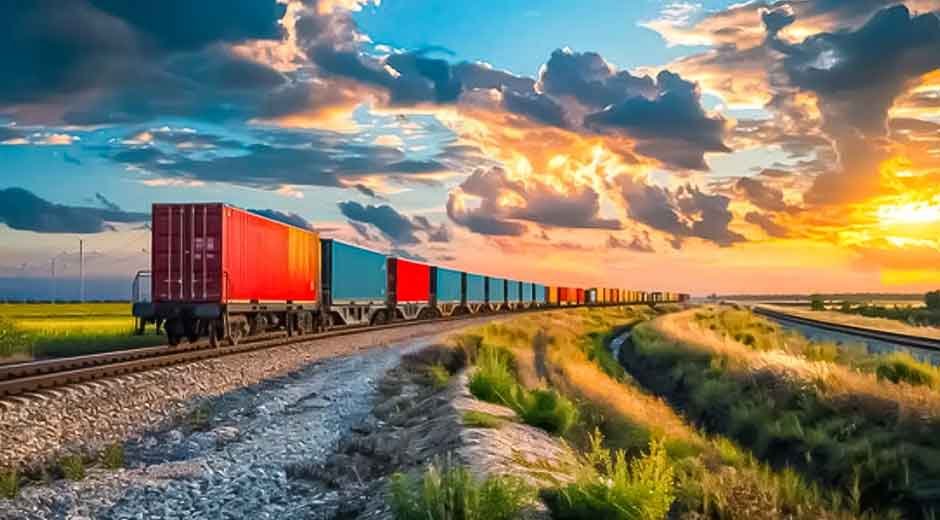Skip to the good bit
ToggleUS intermodal rail terminals are the silent powerhouses behind everything from your morning coffee to your latest online shopping delivery. Imagine giant train yards where shipping containers seamlessly transfer between ships, trucks, and trains. These terminals keep America moving efficiently, saving businesses money while reducing highway traffic and environmental impact. Let’s explore how these critical hubs operate, where they’re located, and why they matter more than ever in today’s supply chain.
What Exactly Are US Intermodal Rail Terminals?
At their core, US intermodal rail terminals are specialized facilities where shipping containers and trailers switch between transportation modes, primarily between trucks and trains. Think of them as the ultimate transfer stations in our national freight network. Here’s what happens inside:
- Cargo Handoffs: Giant cranes lift containers from trains onto truck chassis (specialized trailers) or stack them in storage yards. For example, at the bustling Joliet/Elwood terminal near Chicago, over 6,500 acres handle transfers between BNSF and Union Pacific trains.
- Temporary Storage: Containers wait here until trucks take them to warehouses, ports, or stores. Efficient stacking systems—sometimes five containers high—maximize space.
- Equipment Management: Terminals manage chassis pools (the wheels for containers) and containers themselves, ensuring quick access for truckers.
North America has roughly 2,270 rail facilities handling some intermodal freight, but fewer than 200 are major container terminals. Most are privately owned by just seven Class I railroads, like BNSF or CSX. Strategically clustered near ports (Los Angeles, New York) and inland logistics hubs (Chicago, Memphis), they balance market access with efficient transport routes.
Why Shippers Choose Intermodal Transportation Solutions
Businesses increasingly turn to intermodal rail terminals for three compelling reasons:
- Cost Savings: Rail moves freight at 10–15% lower costs than trucks for journeys over 500 miles. This gap widens when fuel prices spike or during tight truck capacity. CSX notes shorter hauls (500–1,000 miles) are now viable too, due to terminal investments.
- Sustainability: Trains are 3–4 times more fuel-efficient than trucks. Shifting freight from road to rail slashes greenhouse gas emissions by up to 75% per container. One intermodal train also replaces 300 trucks, easing highway congestion.
- Reliability & Scale: Unlike trucks facing driver shortages, railroads offer consistent capacity. Major lanes like Los Angeles-to-Chicago run unit trains daily, moving hundreds of containers at predictable schedules. Terminals with 24/7 operations (like Schneider’s preferred ramps) further ensure flexibility.
For international shippers, on-dock rail terminals at ports like Los Angeles or New York allow containers to transfer directly from ships to trains. This avoids 300% drayage cost spikes seen during port disruptions. Domestic-focused shippers use transloading—transferring imports from 40-foot international containers into larger 53-foot domestic ones. Three domestic boxes fit the freight of five international ones, cutting costs and empty container returns.
Rails are widening their discount to truckload rates to 30%, making intermodal transportation solutions in Orlando irresistible for budget-conscious shippers. Pricing will rise 5–7% by late 2025 due to new labor deals, so acting early locks in savings.
How These Terminals Operate: Behind the Scenes
Key Equipment at Intermodal Terminals
| Equipment Type | Purpose | Unique Challenge |
| Overhead Cranes | Move containers between trains, trucks, and stacks | Newer models can “dig” into stacks without moving top containers |
| Chassis | Wheeled frames allowing the truck transport of containers | Aging fleets (15-20 years old) cause breakdowns and shortages |
| Domestic Containers (53 ft) | Haul consumer goods within North America | Require dedicated chassis pools |
| International Containers (20/40/45 ft) | Carry global imports/exports | Complex management due to empty repositioning needs |
Terminal operations hinge on speed and precision. When a train arrives, massive cranes—some electrified to cut diesel use—unload containers within minutes. Containers are either:
- Grounded: Stacked on the ground, requiring a crane for pickup. Cost-efficient but slower.
- Wheeled: Pre-mounted on chassis for immediate truck pickup. Faster but chassis-dependent.
A critical process is the interchange, where containers switch between railroads. There are two methods:
- Steel-Wheel Interchange: Containers stay on railcars as they’re transferred between railroads. This seamless method avoids truck drayage, cuts costs, and speeds up border crossings like Laredo, Texas.
- Rubber-Tired Interchange: Trucks move containers between terminals of different railroads. Though flexible, this adds handling, costs, and delays.
Terminals also fight constant chassis shortages. With fleets averaging 15–20 years old, breakdowns and blown tires are common. Production delays and importers holding containers longer worsen the scarcity.
Where to Find Them: America’s Intermodal Hotspots
US intermodal terminals concentrate in two key areas:
- Coastal Gateways: Near major ports like Los Angeles/Long Beach and New York/New Jersey. These handle international containers straight from ships via on-dock or near-dock rails. The Watson Land Company’s facilities near LA ports, for instance, offer “immediate access to intermodal rail” just 20 minutes away.
- Inland Hubs: Located in logistic heartlands like Chicago, Memphis, and Kansas City. Chicago alone is served by 14 major terminals! These hubs sort freight for regional distribution. For example, CenterPoint’s Joliet/Elwood park near Chicago connects to 65% of the U.S. population within a day’s drive.
Top 10 Intermodal Terminal Locations
| Location | Key Terminals | Rail Operators | Unique Advantage |
| Chicago, IL | 14+ terminals | BNSF, UP, CSX, CN | Nation’s rail crossroads |
| Los Angeles/Long Beach, CA | ICTF, Pier J | BNSF, UP | Direct port access |
| Joliet/Elwood, IL | BNSF Logistics Park, UP Terminal | BNSF, UP | 6,500-acre inland port |
| Kansas City, MO | Logistics Park KC | BNSF | Surrounded by warehouses |
| Memphis, TN | CN/CSX terminals | CN, CSX | Central U.S. distribution |
| North Baltimore, OH | CSX Northwest Ohio | CSX | 2M container annual capacity |
| Santa Teresa, NM | UP Intermodal Ramp | UP | $400M facility near the Mexico border |
| Atlanta, GA | Multiple terminals | NS, CSX | Major Southeast hub |
| Dallas/Fort Worth, TX | UP, BNSF terminals | UP, BNSF | Serves the growing Texas economy |
| Savannah, GA | Port terminals, pop-up yards | CSX | Relieves port congestion |
Railroads increasingly build terminals farther from crowded cities. BNSF’s Logistics Park Kansas City, 35 miles southwest of downtown, sparked local warehouse growth, creating self-sustaining logistics communities. Similarly, Union Pacific’s $400 million Santa Teresa, NM, terminal near the Mexican border offers expanded capacity and automated gates.
Tackling Tomorrow: Innovation and Efficiency Upgrades
Facing labor shortages and volume swings, terminals are innovating aggressively:
- Stacking Smarter: With urban expansion space-limited, terminals use high-reach cranes to stack deeper. As engineer Chad Hewitt explains, new cranes can retrieve a bottom container in a stack of five by moving just four boxes, versus 24 moves with older handlers.
- Going Electric: Terminals are replacing diesel cranes with electric models. These capture energy during lowering movements, cutting electricity costs by 30%. Electric truck fleets for container shuffling are also being tested.
- Automation & AI: Semi-automated cranes allow one operator to manage multiple machines remotely. GPS tracking and “smart gates” slash truck wait times by 40%. Georgia Ports used pop-up inland yards during 2021 congestion, cutting container dwell times from 17 to 10 days.
- Expanding Inland Networks: Railroads are adding “paper ramps”—small depots serviced by trucks from major terminals. This eases congestion at core hubs while extending market reach.
Labor shortages accelerated these changes. “Human-assisted automation” lets workers manage exceptions remotely while machines handle routine lifts. This flexibility is vital as volumes grow, projected at 3% annually through 2025.
The Road Ahead: Growth Meets Challenges
The intermodal industry, valued at $29.37 billion in 2022, is projected to grow at 13.8% annually through 2029. Yet real hurdles remain:
- Chassis Shortages: Production delays and aging fleets (average age: 15+ years) force terminals to spend millions on replacements.
- Volume Swings: COVID-19 exposed how demand spikes (e.g., 40% higher 2021 goods spending) can overwhelm networks. Railroads now add flexible storage yards in “low-cost real estate” areas to absorb peaks.
- Competition: Trucking still dominates for short hauls. Rail must improve service reliability—”our service is our product,” notes Norfolk Southern’s Andrew Lynch.
Despite this, 2025 looks promising. Tariff concerns are pulling imports forward, boosting volumes.
Your Gateway to Smarter Shipping
US intermodal rail terminals are evolving from static yards into dynamic, tech-driven hubs that strengthen supply chains against disruptions. They offer shippers a rare trifecta: lower costs, smaller environmental footprints, and scalable capacity unmatched by trucks alone. Whether you’re moving electronics from Shanghai to Schaumburg or grain from Kansas to Tokyo, these terminals unlock efficiency.
As Evan Armstrong of Armstrong & Associates observes, the industry is returning to “a more normal growth pattern” post-pandemic. With strategic investments in automation, greener equipment, and inland networks, terminals won’t just keep up—they’ll define the future of freight. The time is now to plug into their potential.







